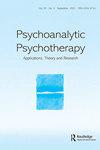Editorial
IF 1.2
Q1 PSYCHOLOGY, PSYCHOANALYSIS
引用次数: 0
Abstract
27 September 2020 marked the one-hundredth anniversary of the first patient being seen at the Tavistock Clinic. Over the following year, the Tavistock & Portman NHS Foundation Trust has marked this centenary with a series of events celebrating its history and exploring contemporary issues in relation to identity, relationships and society. This special issue is a collection of papers based on presentations from the centennial celebrations. The authors, most of whom are past and present clinicians of the trust, describe the historical and contemporary work of various departments and services and consider how to draw on this heritage to provide valuable responses to contemporary and future challenges. The Tavistock Clinic was established by Hugh Crichton-Miller, taking its name from its original location at 51 Tavistock Square. Crichton-Miller’s aim was to provide civilians with the kind of treatments that he and other doctors had developed using Freud’s theory of neurosis in the treatment of shell-shocked soldiers during World War 1. So, it seems fitting that the first three papers in this special issue address the subject of trauma. In ‘The Tavistock trauma service centenary lecture’ Jo Stubley describes the history and theoretical developments of clinical work with adult patients in the Tavistock Trauma Service. This service was founded in 1987 in response to the Herald of Free Enterprise Ferry Disaster. Using a psychoanalytic model of trauma developed by Caroline Garland, the unit initially worked with adults who had experienced a single episode trauma, offering a brief intervention of six consultations. However, over time, an increasing number of referrals have been received for people who have experienced chronic, repetitive and sustained traumas. Working with complex trauma has required changes to the original model, and advances in attachment and mentalisation theories and neuroscience have informed developments in the work of the unit. A range of therapeutic interventions, both individual and group, psychotherapeutic, physical and social is now provided. The second paper, by Graham Music, focuses on the developing field of trauma work, and the need to attend to the body. In ‘Being safe and being brave: new thoughts on trauma, and adaptations to technique’, Music describes his work with four young people to illustrate his journey as a trauma therapist, and the development of the techniques that he uses. Much of this requires a focus on the body, initially to develop feelings of safety and facilitate trust. Once this has been achieved the work can move towards emotional expression, again paying编辑
2020年9月27日是塔维斯托克诊所收治首位患者100周年纪念日。在接下来的一年里,塔维斯托克和波特曼NHS基金会信托通过一系列庆祝其历史和探索与身份、关系和社会相关的当代问题的活动来纪念这个百年纪念。这期特刊是根据一百周年庆祝活动的报告收集的论文。作者,他们中的大多数是信托的过去和现在的临床医生,描述了各个部门和服务的历史和当代工作,并考虑如何利用这一遗产为当代和未来的挑战提供有价值的回应。塔维斯托克诊所由休·克莱顿-米勒(Hugh Crichton-Miller)建立,以其位于塔维斯托克广场51号的原址命名。克莱顿-米勒的目的是为平民提供一种治疗方法,这种治疗方法是他和其他医生利用弗洛伊德的神经症理论在第一次世界大战期间治疗弹震症士兵时开发出来的。所以,这期特刊的前三篇论文讨论创伤这个主题似乎是合适的。在“塔维斯托克创伤服务百年讲座”中,Jo Stubley描述了塔维斯托克创伤服务中心成年患者临床工作的历史和理论发展。这项服务成立于1987年,以应对自由企业先驱渡轮灾难。使用卡洛琳·加兰(Caroline Garland)开发的创伤精神分析模型,该小组最初与经历过一次创伤的成年人合作,提供六次咨询的简短干预。然而,随着时间的推移,越来越多的人转诊经历了慢性,重复性和持续性的创伤。处理复杂的创伤需要改变原来的模型,依恋和心智化理论以及神经科学的进步为该部门的工作发展提供了信息。现在提供了一系列治疗干预措施,包括个人和团体、心理治疗、身体和社会。第二篇论文由Graham Music撰写,重点关注创伤工作的发展领域,以及关注身体的必要性。在《安全和勇敢:对创伤的新思考,以及对技术的适应》一书中,Music描述了他与四个年轻人的合作,以说明他作为创伤治疗师的历程,以及他所使用的技术的发展。其中大部分都需要关注身体,最初是为了培养安全感,促进信任。一旦实现了这一点,工作就可以转向情感表达,再次付费
本文章由计算机程序翻译,如有差异,请以英文原文为准。
求助全文
约1分钟内获得全文
求助全文
来源期刊

Psychoanalytic Psychotherapy
PSYCHOLOGY, PSYCHOANALYSIS-
CiteScore
1.30
自引率
37.50%
发文量
22
期刊介绍:
Psychoanalytic Psychotherapy publishes original contributions on the application, development and evaluation of psychoanalytic ideas and therapeutic interventions in the public health sector and other related applied settings. The Journal aims to promote theoretical and applied developments that are underpinned by a psychoanalytic understanding of the mind. Its aims are consonant with those of the Association for Psychoanalytic Psychotherapy in the NHS (APP in the NHS) in promoting applied psychoanalytic work and thinking in the health care system, across the whole age range.
 求助内容:
求助内容: 应助结果提醒方式:
应助结果提醒方式:


